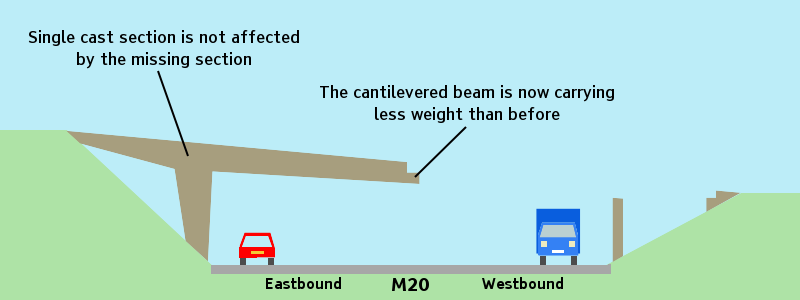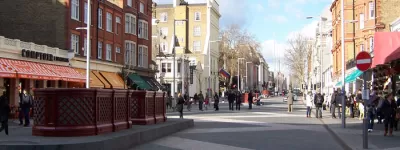On 27 August 2016, the footbridge carrying East Street over the M20 in Kent between junctions 3 and 4 collapsed onto the westbound carriageway. A biker narrowly escaped disaster by jumping from his bike, which ended up directly below the collapsed beam, and a large HGV in lane 1 was crushed.
The collapse caused the M20 and M26 to be closed for more than 24 hours while the wreckage was removed and the road repaired, causing horrendous delays across the whole of Kent's major roads on a bank holiday weekend that is normally one of the busiest days of the year.
How did the bridge collapse? And could it happen again?
What happened?
Just after midday on Saturday 27 August, a lorry carrying some heavy construction plant, including a mechanical digger, struck the East Street footbridge while travelling westbound on the M20. The southern half of the footbridge collapsed onto the road, striking another lorry and a motorbike.
It appears that one of the items the lorry was carrying - perhaps the mechanical digger - struck the deck of the footbridge. The deck was pushed sideways off its mountings. With nothing to support it, it then collapsed onto the road. The supporting bridge piers were left in place. Because the footbridge was narrow — perhaps less than 2m (6ft) wide — the deck only had to be pushed a short distance to be dislodged altogether.
The deck landed on the lorry and another that was alongside it, and appears to have broken in two across the top of them as it landed, pinning them in place.
It's not clear why the lorry that caused the collapse was travelling on the hard shoulder, but the driver may have become aware there was a problem with the vehicles he was carrying. It's a known problem that the arms of mechanical diggers can begin to lift in transit. Hydraulic fluid can move around from the effect of being bounced up and down on the road, causing moving parts to rise. If the load wasn't properly secured this might have caused part of the lorry's cargo to end up higher than it should have been, bringing it into contact with the bridge.
Why hasn't the rest of the bridge collapsed?
Pictures of the scene show the other half of the footbridge, spanning the eastbound carriageway, hanging precariously in place and completely unsupported. Just after the collapse happened, some traffic continued filtering through under the damaged structure in what looks like a very foolhardy attempt to get away from the scene.
In fact the remaining part of the structure is almost certainly perfectly safe. Highways England placed motion sensors on it before reopening the motorway to ensure it remained stable, but it was left in situ and is unlikely to pose any danger.

The bridge was of an unusual design, partly because the footpath sloped upwards from south to north as it crossed the motorway. The north side of the bridge, which still stands, was cantilevered out over the motorway. It's designed to balance the whole bridge beam on the pillar beside the eastbound carriageway, and is anchored at the footing on the north side. The other half, that has now collapsed, was designed to rest on the end of the cantilever beam.
That means that the part of the bridge that now hangs over the M20, appearing to defy gravity, was designed to do exactly that — and as well as being perfectly well supported as it is, it was also designed to have the weight of the other half of the bridge resting on it. So in this odd state it's not just safe, but actually carrying significantly less weight than it has done for the last 40 years.

Eventually of course the bridge will be replaced and this half will be demolished. It's extremely unlikely that Highways England will simply fix the bridge by putting in a new span to replace the one that fell.
What happens next?
With the wreckage cleared away and the road surface repaired, the M20 reopened to traffic on the afternoon of Sunday 28 August, having been closed for a little more than 24 hours.
East Street bridge will have to be replaced with a new structure, which will probably take the form of a more conventional footbridge. The existing bridge was of an unusual design that wouldn't normally be built now, and the new one is likely to be a lot more conventional in design. A less unusual type of bridge will, of course, mean fewer delays in building the replacement. The new bridge will probably include more space underneath for the M20, as the existing bridge had been a potential problem in plans to provide a fourth lane between the M26 and Maidstone.
It's also likely that some sort of review will be carried out on other motorway bridges that have a joint mid-way across the span like this one did. Such designs are discouraged now, and the ease with which one beam was apparently slid sideways off its bearings is more than a little worrying. Bridge strikes from high vehicles are not unusual and Highways England will want to be certain that there are no other bridges where this is a possibility. There may be a programme of works in the near future to improve the design of other bridges like this one.
For traffic on the M20, business as usual returned a little more than a day after the bridge collapsed. But for Addington residents wanting to walk from one end of East Street to the other, there will be a very long wait until a new bridge is built. In the meantime we can all be glad that nobody happened to be walking across when the accident happened.
Add new comment
Picture credits
- Aerial photograph of the collapsed bridge taken from an original by National Police Air Service Redhill with permission.
- Photograph of footbridge over the M6 adapted from an original by Roger W Haworth and used under this Creative Commons licence.


